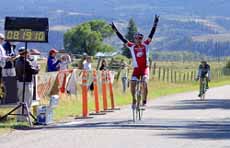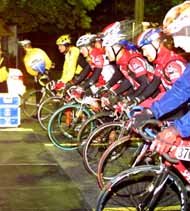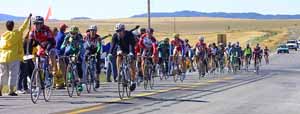Tour de Lotoja
Before the sun rose Saturday morning, in freezing temperatures, 845 men and women from across the nation started to fill up downtown Logan waiting for the 21st annual Lotoja Classic bike race to begin.
Café Ibis employees carried containers full of hot chocolate and coffee across the street to the parking lot on 100 East and Federal Ave., while a van full of Great Harvest bread drove up around 6:15 a.m.
Twelve porta-potties stood adjacent to a few tents where bikers were checking in. For even the fastest racers, it would be over eight hours and 184 miles before they would be able to use a toilet or eat and drink anything while not pedaling a bike.
The first group of bikers left at 6:30 a.m., with groups leaving every 10 minutes for an hour. There were more participants this year than ever before.
Staci Hotchkiss, a volunteer working under the check-in tent Saturday morning, also helped bikers register on Friday.
“About a hundred” registered Friday, raising the total number of participants to 845, she said.
“It’s more than we’ve ever had,” race director Brent Chambers said.
In 2002, 730 riders participated, up from 557 in 2001.
Chambers, who owns Ãpek Inc., the company that has organized Lotoja for six years now, said the race has 17 different categories, nine of which include USCF (United States Cycling Federation)licensed racers, who race several times a year, and eight citizen racer categories. The order in which the bikers started Saturday morning had to do with what category they were in, Chambers said. The first group to leave consisted of categories one, two and three – all licensed participants.
Chambers said the average age for racers in the past years was 39. The oldest participant this year, he said, was Tom Dyson, 73, who used to work at Utah State University. The youngest who has ever finished the race was 13.
Jeremy Smith, this year’s winner, finished the race in 8:19:08, rolling in just after 2:45 p.m. Starting in the first group, he was in the lead pack of only four throughout the entire race.
“I thought I had zero chance against those three guys,” Smith said. “Those last eight miles – I just was able to pull out the sprint.”
Smith, a Salt Lake City resident, finished third last year. As he came across the finish line in Swan Valley, Idaho, he raised his fists and yelled with excitement.
“I couldn’t believe it was happening,” he said. “It felt incredible to be able to pull it off at the end.”
Kirk Eck, last year’s winner and a Smithfield resident, took seventh place this year.
“The last 20 miles [were] pretty much a death march,” he said.
Lotoja, which is named because of its traditional route from Logan to Jackson (LOganTOJAckson), was forced to change its finish line for the second year in a row because of construction in the canyon south of Jackson Hole, Chambers said. The route this year headed west from Alpine Junction, Wyo. onto Highway 26 and north 28 miles to Swan Valley instead of continuing on Highway 89 from Alpine Junction to Teton Village, just past Jackson Hole. The original route (203 total miles) is 19 miles longer than the Swan Valley route.
The race has grown in popularity over its 21 years, Chambers said. More than 25 companies helped sponsor the race this year, and for the first time the Logan Downtown Alliance partnered with Lotoja to produce an even bigger activity, he said. In addition to Logan City’s participation in the race, Chambers said other smaller cities’ Chambers of Commerce have taken an interest as well. Preston, Idaho hosted a town breakfast Saturday morning and Grace, Idaho also had festivities coinciding with the race.
Lotoja had multiple feed zones throughout the race where racers’ family and friends held out water bottles and bags of food for them to grab as they rode by. A new feed zone was made in Preston this year for citizen riders only.
The first feed zone for licensed riders was in Grace. After the racers picked up supplies at the designated feed zones, they threw their used water bottles and empty food bags used during the previous stretch of road. The racers’ support crews, ranging from one to ten persons, then picked up the littered items before driving to the next feed zone to wait for the bikers to arrive.
Vehicles are not allowed to ride alongside racers to hand them supplies in between feed zones. Throughout the race, there were two hills, Treasureton Pass (14 miles north of Preston) and Tincup Pass (18 miles before the Idaho-Wyoming state line), where the first male and female to get to the top were awarded the King and Queen of the Mountain title.
Also new this year, Chambers said, was sending the racers out of Cache Valley through 1000 West instead of Main St.
“To separate the cars and bikes going out of Logan has huge benefits,” he said. The congestion in the previous years, he said, has been very hard to deal with.
This year is also the first year Lotoja has had a fundraising event, Chambers said. Autoliv, a sponsoring company, donated $3,500.
The race brings in more than 160 volunteers, he said, including about 65 from the Cache Valley area. Bridgerland Amateur Radio Club, one group of volunteers, has helped the race communicate by radio for years.
“They have more radio communication going on than ever before,” Chambers said.
The practice they get every year during the race is invaluable for any potential crisis in which only ham radios are available.
Ãpek Inc. assumed direction of the race six years ago after one of Chambers employees who was running the race heard the original organizers were looking for someone else to take over. Chambers said his interest in bike racing and a desire to try something new led him to take on the project.
Jared Dixon, the manager of Sunrise Cyclery in Logan where racers register every year, said the race was started 21 years ago by David Bern and Jeff Keller. The first year only nine people raced. The winning time that year was just over nine hours. Dixon said the fastest time ever has been about seven and a half hours. The race happens every year, no matter what the weather.
Sandy Perrins, of Salt Lake City, finished in second place just three seconds after Smith rode in. Bryson Perry, of Sandy, took third place nine seconds after Perrins.
Jesse Westergard, of North Ogden, came in fourth, 16 seconds after Perry. Westergard had been in first place for several miles toward the end of the race.
The 2003 Lotoja awards ceremony was held in Jackson Hole Sunday morning at 10:00.
-emilieholmes@cc.usu.edu

Jeremy Smith of Salt Lake City is the first to cross the finish line in Swan Valley, Idaho. His official finish time was 8

Cyclists from categories one, two and three cross the starting line on 100 East in Logan at 6

Racers from the first three categories pick up food and water at the China Hat feed zone, north of Soda Springs, Idaho. (Photo by John Zsiray)

